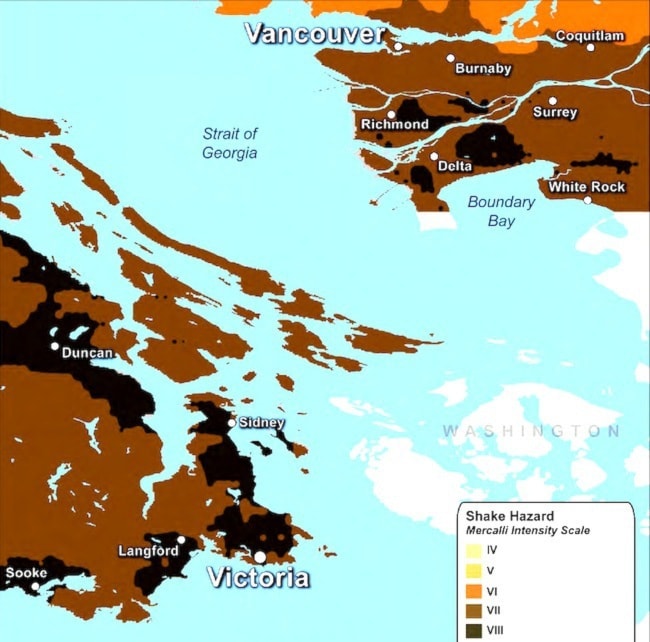Slideshow of maps from Insurance Bureau of Canada report detailing projected shaking intensity and damage in Metro Vancouver and Victoria from a modeled 9.0-magnitude offshore earthquake.
Damage to southwestern B.C. buildings, roads, pipelines and other critical infrastructure could hit $75 billion in a major earthquake, according to a new study.
The commissioned by the Insurance Bureau of Canada modelled a 9.0-magnitude subduction zone earthquake well off the west coast of Vancouver Island and Washington State.
The strongest ground shaking and damage levels would be on the western side of Vancouver Island closest to the epicentre.
But the report projects more overall damage in Victoria due to its many older, vulnerable buildings, as well as in the Lower Mainland from moderate shaking because of the sheer number of buildings and infrastructure at risk.
The modeling forecasts a high shaking intensity in areas such as Delta, Richmond and Victoria, causing extensive damage to unreinforced masonry buildings, including partial collapse.
A large area of Surrey, Burnaby, Coquitlam and Vancouver Island would experience the second-highest level of shaking intensity, significantly damaging poorly built buildings and causing slight to moderate damage to better structures.
The report says lowlands with risky soil types could see significant damage from ground liquefaction, causing buildings to settle, tilt or slide.
"Liquefaction damage is expected in Delta, Richmond and portions of Burnaby, Surrey, Port Coquitlam, Pitt Meadows, Maple Ridge and Abbotsford due to the loose granular sediments, high water table, and long duration ground shaking."
It also cautions ground failure from liquefaction can also have a "great impact" on roads, freeways, bridges and buried pipelines.
Some dikes around the Fraser River delta area may also be affected, compromising their ability to prevent flooding if a tsunami wave also arrives at high tide.
Most low-rise residential buildings in Richmond are expected to face moderate damage, as well as government buildings around Richmond City Hall, it says.
The report predicts some roads will be damaged and impassable, water supply and other buried services will be compromised and drivers should expect many bridges to be temporarily closed, if only for a few hours to check for damage that may be slight in most cases.
Vancouver International Airport would likely be cut off by road in the first few days due to the shutdown of access bridges.
And road travel between Vancouver or Richmond and suburbs to the east and south is also expected to be impaired, the report says.
The study predicts a resulting tsunami would cause the greatest damage from flooding along the west coast of Vancouver Island, but waves of up to one metre above normal could also reach some Metro Vancouver shorelines.
The report says some residential buildings in west Richmond could experience substantial tsunami damage.
Earthquake-triggered landslides are a high risk along parts of western Vancouver Island, it says.
And the findings suggest firefighters in Victoria and Metro Vancouver will battle intense local fires, possibly spreading from block to block. Those fires may not ignite immediately, but later, as power transmission is restored and electricity is turned back on in damaged areas.
IBC president Don Forgeron said Canada is unprepared for such a disaster and said the bureau is launching a national conversation on how better to prepare.
"If a mega-earthquake should strike in a densely populated area, insurance alone will not pay for all the damage," he said. "Governments and consumers have a role to play."
While the report focused on a subduction zone mega-quake, it didn't look at the risks of smaller, shallower quakes that seismologists say could also cause severe damage if they strike closer to populated areas.
The report includes detailed maps of projected shaking intensity and damage outcomes in Metro Vancouver and Greater Victoria. (See slideshow above or .)

Insurance Bureau of Canada image
Photo simulation of liquefaction damage in Richmond that may result from a major B.C. earthquake, according to a new study that models the economic impact of a 9.0-magnitude quake in the province. The study, commissioned by Insurance Bureau of Canada, estimates costs as a result of a large quake in B.C. at almost $75 billion.



